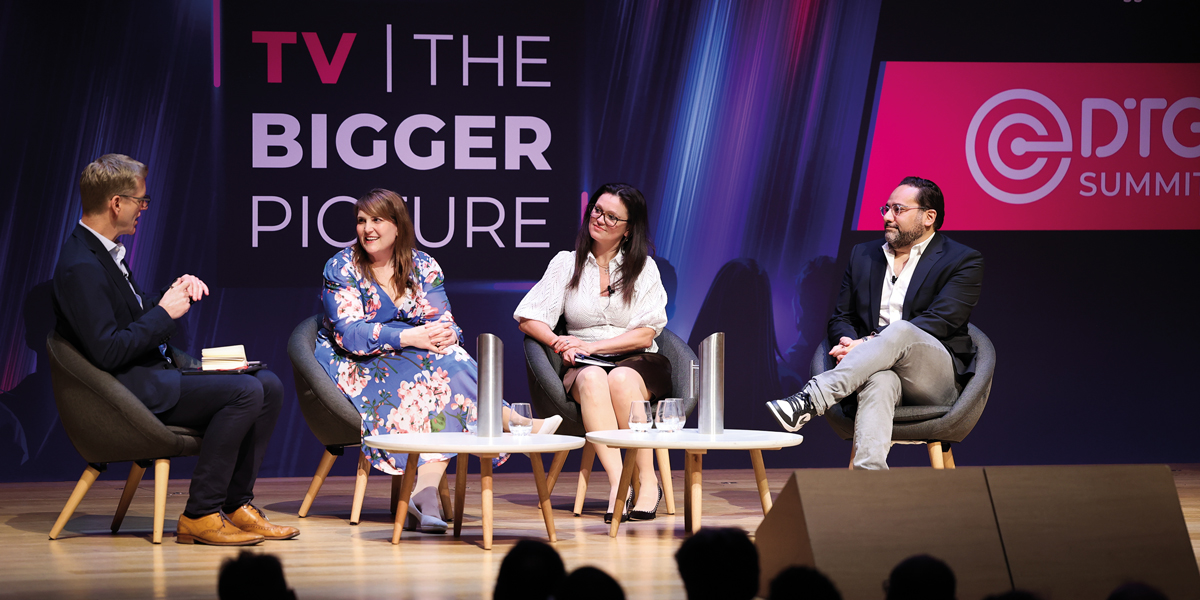DTG Summit 2024

Posted on Jun 21, 2024 by FEED Staff
The bigger picture
Leading voices in today’s media landscape gathered at the Digital TV Group event to evaluate the TV industry – celebrating its strengths, analysing its obstacles and identifying key areas for improvement
Words by Katie Kasperson
On a rare sunny day in London, Digital TV Group (DTG) hosted TV: The Bigger Picture, an annual nine-to-five summit which brings the technology, television and media sectors together. With each passing year ushering a host of changes, from evolutions in consumer behaviour to shifts in the ongoing streaming wars, the event regularly unpacks the TV industry’s biggest challenges and opportunities.
Kicked off by Julia Lopez MP’s ministerial keynote, the summit’s various speakers covered topics like distribution and discoverability, the state of streamers, balancing people with product and future-proofing via the latest innovations. We heard from experts across both the private and public sectors, who sometimes presented opposing views and even engaged in healthy debates and discussions. It didn’t take long for a few key themes to emerge – but the most critical take-home point was that change is inevitable; what matters is how we address it.
Enough space for everyone
We have heard the term streaming wars thrown about, but its accuracy remains up for debate. Panellists Leah Hooper Rosa (EVP EMEA streaming, Warner Bros Discovery), Kerry Ball (chief commercial and strategy officer, Britbox) and Monty Sarhan (CEO, Sky Showtime) discussed the current streaming ecosystem, paying special attention to password sharing, market saturation, appealing to distinct locales, bundling and serial churners (those who constantly and intentionally swap between streamers).
In a world where consumers are spoilt for choice, introducing a new streaming service might seem counterproductive. But some platforms – Britbox, for instance – have managed to establish a niche and garner an enthusiastic community. “We built a small dinghy with a big engine rather than running a cruiseliner,” says Ball. Audiences turn to Britbox for its high-quality British content, whether that’s a true crime story or a period piece.
It’s naive to assume carving out a corner of the market is all it takes. Despite Britbox centring around British culture, “it needs to resonate in lots of different places,” argues Ball. “We will look to see how we can evolve our proposition in the future, to take into account how to deliver more value in different segments.”
Hayu – created by NBCUniversal – is all about reality TV and unscripted shows. Like Britbox, it revolves around a single genre or special interest. Hendrik McDermott, MD of EMEA networks, Hayu and international direct-to-consumer at NBCUniversal, describes Hayu as an add-on. It’s not meant to replace the standard Netflix, Amazon Prime Video or Disney+ but to complement these services instead – which brings us to bundling.
Streaming services have proven largely unprofitable, with the costs of creating original, high-end content outweighing revenues from subscription fees and advertisements. Many platforms have opted to bundle – or provide multiple services at a discounted rate – to entice consumers; not only will they be paying a lower premium, but they’ll also be juggling fewer subscriptions (making them less likely to churn). As the cost-of-living crisis rages on, we’ll likely see more bundles cropping up.
With all this saturation in streaming comes competition, or the streaming wars. Sarhan opposed this term, arguing a war implies a winner and loser. “There’s room in the marketplace for all of us to win and do well,” he assures. “I’m rooting for [Warner Bros Discovery] and Britbox. When they’re successful, that means I’m successful; it means streaming is growing.”
Meet in the middle
Lately, it seems linear TV is dying – or is at least on the out. The truth lies in the data: younger viewers are watching less traditional TV than ever before – instead turning to platforms like TikTok and YouTube to consume content. Jordan Schwarzenberger, co-founder of Arcade Media, dove into the details of why this might be – and how businesses can keep up.
Schwarzenberger manages the Sidemen, who are “the biggest content creators in Europe,” he says. “They represent a generational shift in content away from centralised programming towards real people telling real stories, having fun with their friends and sharing that on the most effective platform out there, which is YouTube – and now TikTok.”
The Sidemen have built a robust following over the past decade, but Schwarzenberger didn’t want to stop there. “How do we help you build an ecosystem of IP and brands to take it to another level?” he asked them. “This is the big takeaway in the room today – that content and brands need to be thought of in a real 360° way. That’s the opportunity to think about first, rather than individual content or programmes.” We often see celebrities launch product lines or beauty brands – Rihanna (Fenty Beauty), Harry Styles (Pleasing) and Selena Gomez (Rare Beauty) come to mind on the latter, but almost everyone does it. This is the new normal.
Schwarzenberger stresses the importance of building a consumer community. This begins with meeting the audience where they are – and Gen Z is on social media. Channel 4 is a trailblazer in this regard, having launched its YouTube channel, Channel 4.0, in 2022 and having already raked in 374,000 subscribers. Production company A24 is another leading example; by handing full creative control back to filmmakers, it has managed to produce some of the most popular and critically successful projects of the 21st century.
There’s also a rumour that content is moving towards small screens and that young people aren’t buying TVs any more. This is partially true, but thanks to broadband-enabled TVs (which now represent 99% of all TVs on the market), audiences can watch their favourite creators on the bigger screen at home, too.
With the rise of bite-sized content comes an assumed downfall in linear TV. But the numbers demonstrate that linear TV is here to stay – for now. Although they subscribe to streaming services, 79% of British viewers still watch a traditional TV broadcast in a given week (as of 2022, according to Ofcom). While this number is dropping, it will likely be decades before streamers and social platforms replace broadcasters – if they do at all.
No viewer left behind
All’s fair in love and war, although what about TV?
Yih-Choung Teh, Ofcom’s group director for strategy and research, briefly discussed universality and how internet-based viewing will impact the future of TV distribution. Teh noted that certain audiences – such as those over 75 years old, in a lower socioeconomic group or with a disability – are at risk of being left behind, since these viewers are more likely to watch digital terrestrial television (DTT) only.
Broadband-enabled TVs are undoubtedly the future, but this rests on the assumption that viewers can access the internet. With our lives increasingly wrapped up in digital worlds, it’s imperative to ensure access to everyone – not just those who can afford an additional bill among a cost-of-living crisis.
Smart TVs provide better usability than their DTT counterparts, with more intuitive interfaces and the option to add subtitles and/or closed captions. These benefits can encourage people to purchase broadband-enabled TVs, which can be relatively inexpensive.
In an effort to bring high-quality content to audiences at no cost, Everyone TV launched Freely, a new streaming service blending Britain’s largest public broadcasters into one platform and delivering both live and on-demand content. With initiatives like these, Britain’s TV industry inches closer to true universality.
An open road
An all-day affair, the DTG summit touched on even more topics in the afternoon, from diversification to personalisation, comparing the endless supply of content to an all-you-can-eat buffet. With more choices than ever before, it’s not a bad time to be a consumer – but for companies, it can be nearly impossible to keep pace with demand or anticipate the next hit series. Mix in new technologies like virtual production, augmented reality and artificial intelligence, and the TV landscape looks far different from just a few years ago.
This is why events like the DTG summit are critical to the industry, enabling it to progress and evolve while maintaining what makes TV so special. It’s a chance for business leaders, government officials, media experts and – most importantly – audiences to discuss, debate and ultimately decide what’s best for everyone. TV’s future is wide open.
This feature was first published in the Summer 2024 issue of FEED.









